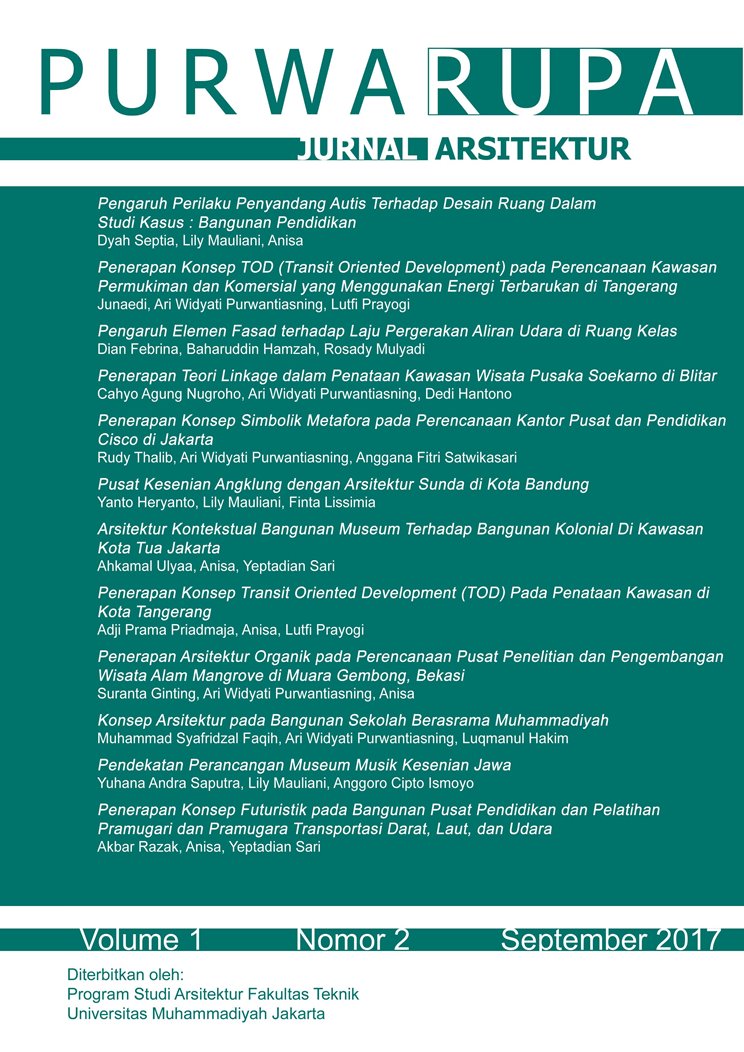Pengaruh Perilaku Penyandang Autis Terhadap Desain Ruang Dalam Studi Kasus : Bangunan Pendidikan
DOI:
https://doi.org/10.24853/purwarupa.1.2.1-12Abstrak
ABSTRAK. Peningkatan jumlah penyandang autis semakin lama semakin mengkhawatirkan, maka dari itu diperlukan penanganan khusus yang dapat membantu para penyandang agar dapat menyesuaikan diri dengan lingkungannya. Menurut data Badan Pusat Statistik pada tahun 2010 prevalansi penyandang autis setiap tahun semakin meningkat, diperkirakan mencapai 2,4 juta orang dari 237,5 juta penduduk dengan laju pertumbuhan 1,14 persen. Jumlah autisme di Indonesia diperkirakan mengalami peningkatan sekitar 500 orang setiap tahunnya. Penyandang autis mempunyai karakteristik khusus, yang dalam tingkatan tertentu tidak dapat berinteraksi secara normal dengan individu yang lain. Maka dari itu dibutuhkan fasilitas pendidikan dengan desain khusus untuk penyandang autis, terutama terhadap desain ruang dalam. Dalam mengetahui desain yang baik untuk penyandang autis, maka kami mengadakan penelitian di daerah Jakarta dan Bogor. Adapun kesimpulan yang didapat dari penelitian ini adalah desain pola yang menciptakan ruang sosialisasi sangat penting mengingat bahwa penyandang autis memiliki masalah pada interaksi sosialnya sehingga ruang-ruang dalam akan di tata secara radial dimana ruang-ruang kelas saling berhadapan yang dipisahkan oleh koridor yang akan menciptakan ruang interaksi sosial dan berpusat pada satu titik dimana satu titik tersebut menjadi ruang berkumpul dan bersosialisasi. Kata Kunci: bangunan pendidikan, penyandang autis, ruang sosialisasi ABSTRACT. The increasing numbers of people with autism escalate into a worrying level. Therefore, they need special treatment so they can adapt to the environment. According to Badan Pusat Statistik, prevalence of people with autism increasing every year up to 1,14 percent or 2,4 million people out of 237,5 million citizen. People with autism in Indonesia estimated to increase approximately 500 people each year. People with autism have special characteristics, which mean they can’t interact normally with other people. Hence, ther is a need for education facilities with special design specifically for them, particularly inner spatial design. This study occurs in Jakarta and Bogor to find out the best design that is suitable for people with autism. The conclusion of the study is that the certain desain that creates a friendly environment for people wth autism to interact and communicate each other is very important in view of their social limitation. The best solution is to design space in radial pattern where every class facing each other and separated by corridor that will create social interaction space and centered on one point where it became assembly and socialization center. Keywords: educational building, people with autism, socialization room##submission.downloads##
Diterbitkan
Terbitan
Bagian
Lisensi
COPYRIGHT POLICY
The author(s) of an article published in the Jurnal Teknologi retains ownership of the intellectual property rights in work (s).
PUBLISHING RIGHTS
The author(s) of an article published in the Jurnal Teknologi have unrestricted publication rights. The authors give the Jurnal Teknologi the right to publish the article and designate the Faculty of Engineering Universitas Muhammadiyah Jakarta Publishing as the original publisher of the article.
LICENSING POLICY
Journal of Mechanical Engineering and Sciences is an open-access journal that follows the Creative Commons Non-Commercial 4.0 International License (CC BY-NC 4.0), which states that:

Under this license, the reusers must give appropriate credit, provide a link to the license, and indicate if changes were made. Users may do so in any reasonable manner, but not in any way that suggests the licensor endorses users or their use.
Please take the time to read the whole license agreement (https://creativecommons.org/licenses/by-nc/4.0/). As long as reusers follow the license conditions, the owner cannot withdraw these freedoms. The following components are included under this license:
 Attribution: Users must provide appropriate attribution, including a link to the license, and indicate whether or not they made any modifications. Users are free to do so reasonably, but not in a manner that indicates the licensee approves of their usage.
Attribution: Users must provide appropriate attribution, including a link to the license, and indicate whether or not they made any modifications. Users are free to do so reasonably, but not in a manner that indicates the licensee approves of their usage.
 NonCommercial: Users may not use the material for commercial purposes.
NonCommercial: Users may not use the material for commercial purposes.

